Physical Address
304 North Cardinal St.
Dorchester Center, MA 02124
The last 3 decades have seen major improvements in the preoperative, surgical, and longer-term management of children undergoing congenital cardiac surgery, resulting in an ever-expanding population of young adults with congenital heart disease (ACHD). A regional longitudinal analysis in Quebec demonstrated that between 2000 and 2010, the prevalence of all ACHD increased by 57%, and severe ACHD increased by 55%, compared with 11% and 19%, respectively, for children. By 2010 the overall prevalence of ACHD was 6.12 per thousand, and adults accounted for two-thirds of the entire congenital heart disease (CHD) population.
The long-term hemodynamic stress coupled with repeated surgical intervention imposed in varying congenital cardiac lesions creates an ideal environment for the genesis of various tachycardias, specifically reentrant circuits dependent on central fixed obstacles to conduction and variable sites of slow conduction or functional conduction block. As such, the overall prevalence of atrial tachycardias in ACHD has been documented at 15% and is higher in more complex congenital lesions, such as Ebstein anomaly (33%), transposition of the great arteries (TGA) (28%), and the Fontan circulations (24.2%). The 20-year risk for developing atrial tachycardia is 7% in a 20-year old patient and 38% in a 50-year old patient, such that a 20-year old patient with ACHD has the same arrhythmia risk as a 55-year old within the normal population. Perhaps most concerning is the finding that atrial tachycardia in ACHD is associated with double the risk for cerebrovascular events and heart failure and a 50% increase in mortality. These findings have led to the apt description of “young patients with aged hearts.”
In many ACHD patients who have been well palliated and lead functionally normal lives, the emergence of atrial tachycardia often presents the first need for intervention in many years and has major implications for quality of life in young adults with careers and families. In a proportion of patients, however, perhaps best typified by those with a univentricular or Fontan circulation, the onset of arrhythmias may herald the beginning of a gradual hemodynamic decline. As such, prompt recognition and management of atrial tachycardia in all patients with ACHD is imperative to prevent the often significant and progressive morbidity.
Congenital cardiac lesions create unique hemodynamic stressors on the developing atrial myocardium: chronic volume loading from regurgitant atrioventricular (AV) valves and intracardiac shunts; pressure loading from stenotic AV valves or elevated end-diastolic pressures in noncompliant ventricles; cyanosis; and the effects of multiple atrial incisions during cardiac surgery and cardiopulmonary bypass. These factors create an electrophysiologic (EP) substrate that satisfies the fundamental criteria for reentry, which are adequate central and lateral boundaries to prevent short circuiting, a path length that exceeds the wavelength determined by effective refractoriness and conduction velocity of atrial myocardium, and the potential for unidirectional block of initiating impulses.
Early animal models of right atrial (RA) enlargement created by excision of the tricuspid valve septal leaflet via a right atriotomy and pulmonary artery banding demonstrated easily inducible, sustained arrhythmias with electrocardiographic (ECG) and intracardiac electrogram (EGM) morphology consistent with atrial flutter (AFL), which could not be induced in sham animals. Histologic analysis demonstrated myocyte hypertrophy and increased intercellular connective tissue, but transmembrane potentials were no different in study animals compared with controls, suggesting the effect was independent of changes in atrial myocyte EP parameters.
Typical AFL is perhaps the best studied atrial arrhythmia, the mechanism for which has been well understood for some time (see Chapter 78 ). A reentrant wavefront propagates counterclockwise (or clockwise) around the tricuspid valve traversing the inferior cavotricuspid isthmus (CTI), sustained not only by RA size but also by the presence of conduction block at the crista terminalis (CT) on the posterolateral aspect of chamber. Initial human mechanistic studies demonstrated that transcristal conduction was possible during sinus rhythm and pacing at longer cycle lengths (CLs) but was prevented during pacing at shorter CLs and during AFL by the development of functional conduction block, facilitated by the preferential end-to-end distribution of gap junctions within the crista, leading to anisotropic conduction. , Slowing of transverse conduction across the CT, and hence development of conduction block, has been shown experimentally to increase with age. ,
The mechanism by which atrial dilation may promote typical AFL has been studied in patients with unrepaired atrial septal defects (ASDs) and with no prior arrhythmic history that may have facilitated atrial remodeling. Chronic atrial dilation led to conduction delay at the CT as defined by the magnitude of, and delay between, double potentials recorded at this site. Additionally, there was a trend toward increased atrial effective refractory periods and sinus node dysfunction but no changes in conduction velocity in the RA free wall. These findings were not present in age-matched controls. Despite ASD closure, conduction block at the crista and atrial dilation were still present at follow-up evaluation, suggesting that persistent atrial dilation and conduction delay at the crista support AFL late after ASD closure. Similar EP changes have been documented in the left atrium (LA) of patients with ASDs, including chamber dilation and electrical scar with widespread changes in conduction velocity characterized by fractionated EGMs and double potentials and, similar to the RA, an increase in effective refractory periods. This remodeling was associated with an increased propensity to atrial fibrillation (AF). Atrial remodeling secondary to chronic atrial arrhythmias has also been shown in animal models using an intercaval to RA appendage Y-shaped incision to facilitate AFL induction. Sustained typical AFL led to a significant decrease in both atrial refractoriness and conduction velocity, with widening of the excitable gap from 13% to 46% of the flutter circuit length. This not only stabilized the AFL circuit but also, with appropriate triggers, facilitated the induction AF.
Arrhythmia mechanisms are highly varied in ACHD. Classically these lesions are associated with macroreentrant atrial tachycardia (MAT) using sites of fixed and functional conduction block as central obstacles and narrow channels of viable but slowly conducting myocardium that ensure that the reentrant wavefront is always approaching excitable myocardium. Increasingly, however, other mechanisms have been recognized, including focal atrial tachycardias (FAT) and common arrhythmias, such as atrioventricular nodal reentrant tachycardia (AVNRT), which, because of anatomic and EP remodeling, may have different intracardiac activation patterns from those seen in structurally normal hearts. As the population ages, AF is increasingly recognized and represents a new challenge in arrhythmia management within this population. Finally, specific lesions may be associated with arrhythmias as part of the underlying pathophysiology rather than as a consequence of remodeling and surgical intervention, perhaps best typified by Ebstein anomaly. In approaching different mechanisms, a simple anatomic categorization that may be helpful is to consider separately those arrhythmias associated with biventricular repair, those associated with univentricular repair, and those associated with the underlying cardiac lesion.
In most forms of CHD, the anatomic anomalies permit surgical creation of a biventricular circulation, including atrial and ventricular septal defects, tetralogy of Fallot variants, anomalous pulmonary venous drainage, truncus arteriosus, and TGA.
Using entrainment mapping and multipolar catheters, initial studies identified two obstacles as key to the arrhythmia mechanism: the tricuspid annulus and a right atriotomy incision. , In 15 of 21 circuits mapped by Chan, the CTI was part of the circuit, with successful ablation achieved in 14 of 15 cases. A study by Kalman excluded patients with evidence of CTI-dependent flutter, identifying 11 circuits in 9 patients post-ASD closure where the atriotomy was critical to arrhythmia mechanism, and successful termination could be achieved by creation of a linear ablation lesion between the atriotomy and the tricuspid annulus ( n = 5); the caval veins ( n = 5); and the ASD patch and tricuspid annulus ( n = 1). Subsequent animal studies further demonstrated the mechanism of MAT related to atrial incisions. In seven animals, a right atriotomy was created in the free wall 1 to 1.5 cm anterior and parallel to the CT, whereas in six animals, it was positioned more posteriorly, approximating the crista terminalis; subsequent mapping of induced atrial tachycardia was performed using an epicardial multielectrode array (MEA). In four cases with an anterior lesion, the wavefront rotated around the atriotomy, whereas in three animals with an anterior lesion and all with a posterior lesion, there was functional extension of the fixed line of block to the caval orifices, creating a posterior line of intercaval block and facilitating CTI-dependent atrial tachycardia, suggesting mechanistic commonality between typical periannular AFL and circuits apparently dependent on the atriotomy.
Numerous further studies have documented the arrhythmia mechanism in different ACHD anatomic variants, all supporting the initial mechanistic observations. Typical CTI-dependent AFL was seen in 14 of 20 patients on detailed mapping after a variety of biventricular repairs, accounting for 46% of successfully mapped MAT. Similarly, Delacretaz reported a series of 20 patients, again with differing variants of CHD, in whom 47 different MAT circuits were mapped, with 79% dependent on either the CTI or right atriotomy. Subsequent studies have focused on arrhythmia mechanisms in specific congenital lesions, with similar findings ( Fig. 115.1 ). In 20 patients who underwent clinically indicated EPS 29 ± 15 years after surgical ASD closure, CTI-dependent AFL was present in all 20 patients. Additionally, 14 patients had atriotomy-dependent circuits as part of dual loop tachycardia mechanism, two patients had FAT, and two had AVNRT. Dual-loop tachycardias are well recognized after congenital cardiac surgery and typically display an ECG appearance consistent with CTI-dependent AFL with a second atriotomy-mediated circuit revealed with successful isthmus ablation. In a similar series of 56 patients with tetralogy of Fallot or double-outlet right ventricle (RV) who underwent EPS between 1997 and 2010, of 95 MAT circuits identified, 85% involved the CTI or lateral RA wall consistent with an atriotomy-mediated mechanism.
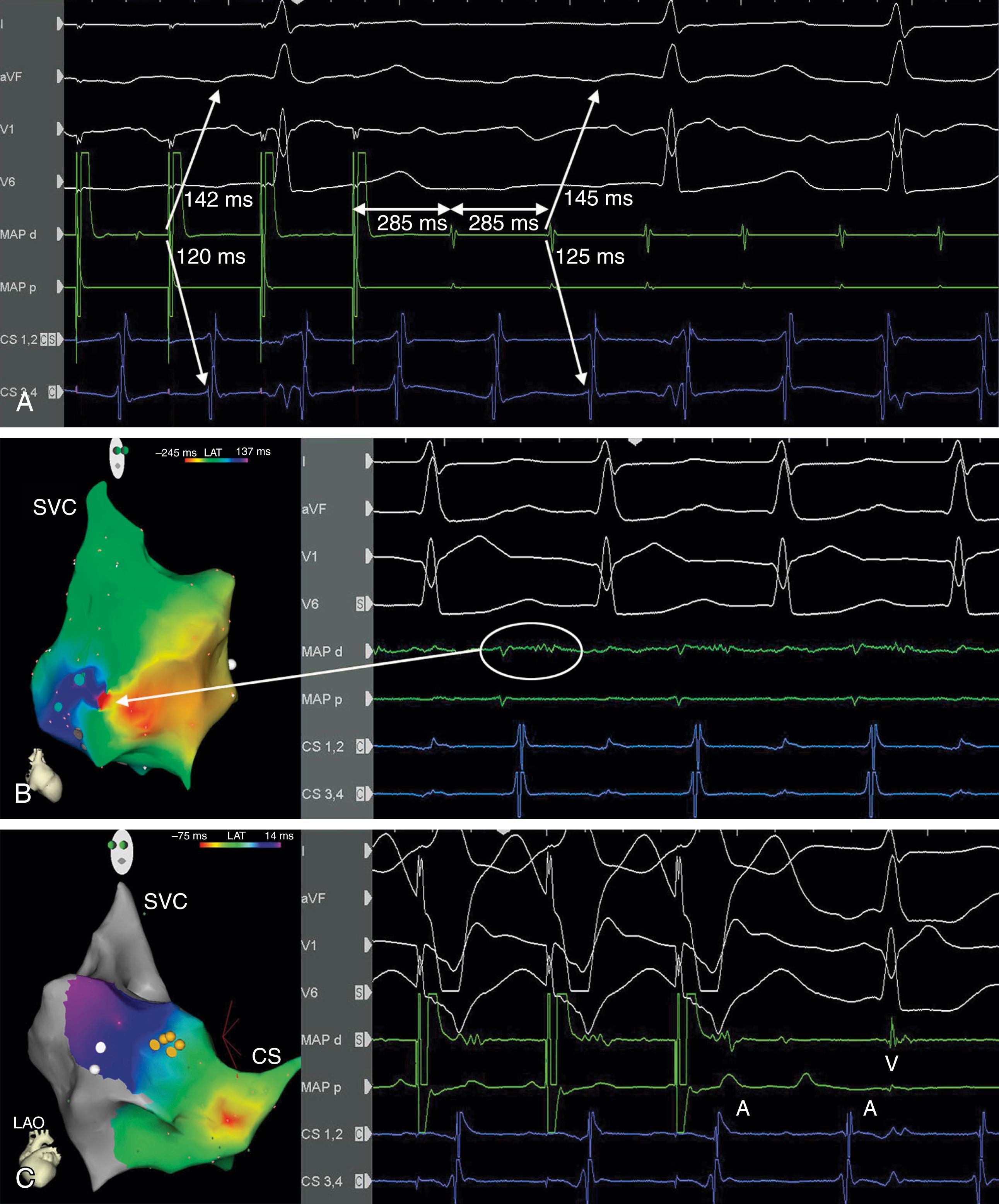
The atrial switch (Mustard or Senning procedure) was the surgical strategy of choice for TGA before the introduction of the arterial switch and is still used as part of the double switch for repair of congenitally corrected TGA. Similar to other patients’ postbiventricular repair, CTI-dependent typical AFL remains the most prevalent mechanism, identified in 18 of 24 (75%) and 10 of 13 (77%) MAT in different series. Other MAT may involve sites remote from the CTI, including the inferior vena cava and pulmonary venous orifices and posterior anastomotic site in the Senning procedure. Other arrhythmia mechanisms have been reported, including FAT and AVNRT. ,
Specific congenital lesions and associated surgical procedures may generate a unique anatomic substrate and hence arrhythmia mechanism. In total anomalous pulmonary venous connection (TAPVC), the four pulmonary veins drain to a confluence posterior to the LA and ultimately to the RA via a vertical vein and the superior or inferior caval vein. Surgical correction involves anastomosis of the confluence to the posterior LA, potentially creating a line of conduction block that may facilitate MAT. Atrial tachycardia has been reported after lung transplantation, and LA reentrant tachycardias were shown in animal models in which incisions were placed, simulating those used in lung transplantation. , Despite these observations, the majority of patients with MAT post-TAPVC appear to also have a CTI-dependent mechanism, likely promoted by RA volume loading.
The Fontan procedure has become synonymous with a variety of different surgical procedures to palliate patients with a functional univentricular circulation, all of which route systemic venous return directly to the pulmonary vascular bed. Eponymously described in 1971, the procedure has undergone numerous surgical modifications, each of which may be associated with different arrhythmia mechanisms. Although this surgery was an incredible advance in the management of CHD, Fontan and Baudet recognized the arrhythmic potential and its deleterious effects on hemodynamics, stating, “One element remains unpredictable: the hemodynamic consequences of an eventual atrial rhythm disturbance, such as an atrial fibrillation or flutter.”
The atriopulmonary Fontan incorporated a surgical anastomosis between the RA roof or appendage and the pulmonary arteries and was the procedure most commonly used for over 20 years, generating a large population of patients with a high incidence of atrial rhythm disturbances. In its adopted role as the subpulmonary chamber, the RA in the atriopulmonary Fontan circulation undergoes severe remodeling, characterized by significant chamber dilation and areas of myocardial scar distant from sites of surgical intervention. In a series of 26 patients (aged 26.8 ± 8.9 years) undergoing detailed EP mapping 18.7 years (± 4.4 years) after the atriopulmonary Fontan procedure, the median RA surface area was 235 cm 2 (range, 136–455 cm 2 ), with atrial volumes recorded up to 500 mL. The median endocardial surface area covered by dense scar (bipolar contact EGM or ≤0.05 mV or not identifiable) was 15.07% (1.89%–56.15%), and the additional area of low-voltage endocardium (bipolar contact EGM ≤0.5 mV) was 25.25% (7.38%–55.11%). Although this represents a significant degree of electrical remodeling, this was less than initially reported by electroanatomic mapping of the Fontan RA, in which viable myocardium existed only as narrow channels between large, confluent areas of scar, permitting multiple reentrant circuits and allowing a “point ablative” strategy.
Contrary to patients with biventricular repairs, CTI-dependent circuits are rare after the atriopulmonary Fontan surgery, largely because of the fact that a significant proportion of patients undergoing this surgery during this era had tricuspid atresia, which makes such a mechanism much less likely but not impossible. The vast majority of MATs use areas of scar and natural anatomic obstacles as central barriers to conduction, often with sites of slow conduction seen along the CT on the posterolateral wall. Scarring within the RA is often distributed primarily on the anterior and lateral surfaces of the chamber and is almost ubiquitously seen at the inferior aspect of the CT on the posterolateral chamber wall. Whether this relates to hemodynamic stress at an anatomically susceptible site or the site of placement of the inferior bypass cannula at the time of surgery is unclear. This area of scarring, combined with a dilated IVC orifice, creates a large nonconductive barrier for MAT, with breakthrough sites from narrow channels seen on the lateral wall, a mechanism that has been termed pericaval reentry . Detailed mapping of 43 different RA arrhythmias using a combination of electroanatomic and noncontact mapping identified the mechanisms as MAT ( n = 33), FAT ( n = 9), and AVNRT ( n = 1). MATs were further divided into wavefront propagation perpendicular to the vertical axis of the RA, dependent on fixed ( n = 7) or fixed and functional ( n = 8) conduction block on the posterolateral wall of the RA at the position of the CT ( Fig. 115.2 ); CTI dependent ( n = 5); and scar-related reentry, in which the wavefront propagates around dense scar or sites of fixed conduction block remote from anatomic obstacles ( n = 13). The site of origin of FAT was from the lateral ( n = 4) and anterior ( n = 2) walls, the CT ( n = 1), CTI ( n = 1), and para-Hisian location ( n = 1).
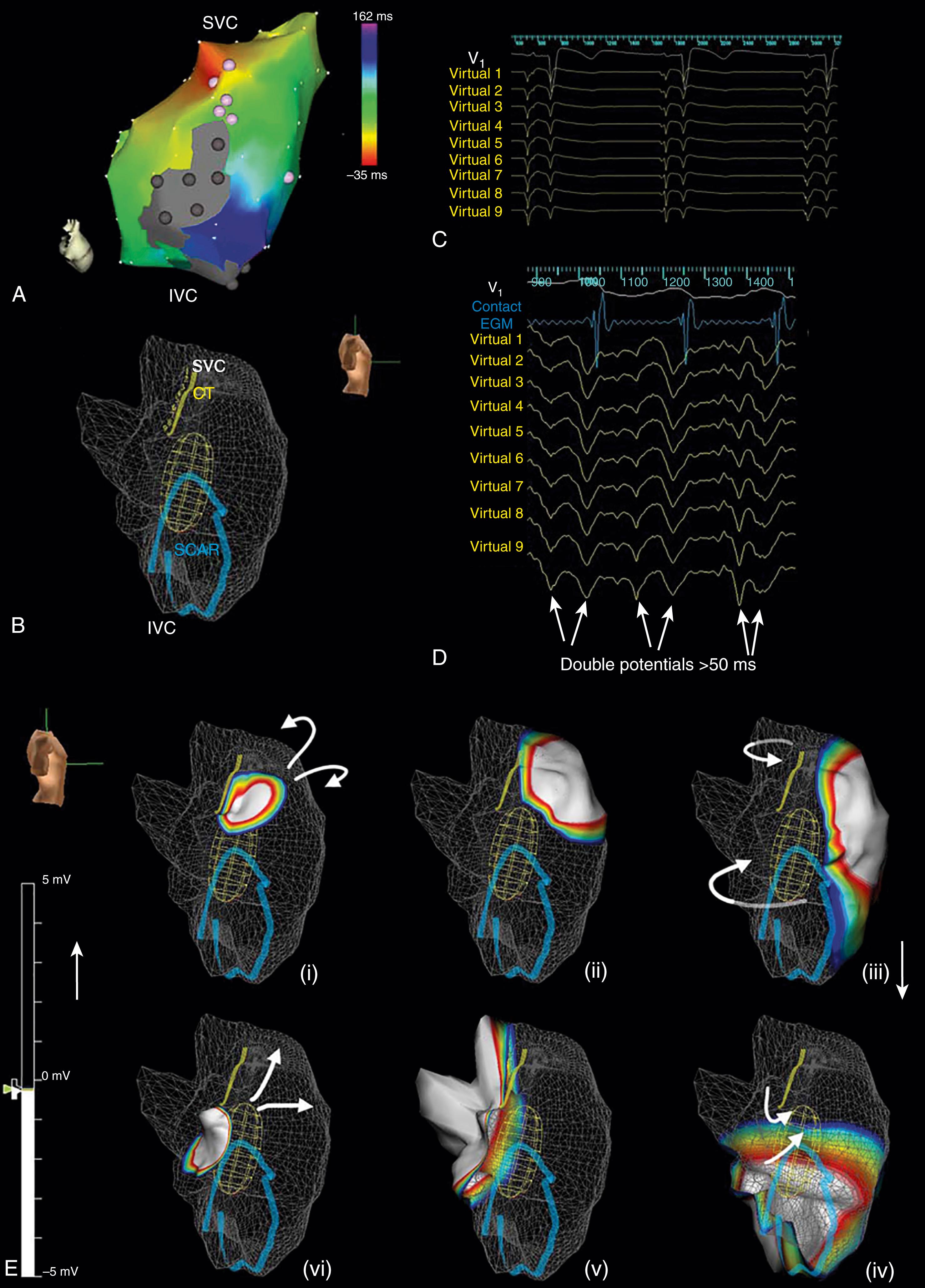
Concentric spread of activation from an apparently focal source, which can be successfully entrained, inferring a microreentrant mechanism, has also been reported. , In one case, electroanatomic mapping alone failed to identify the mechanism, confirmed subsequently by the demonstration of a focal entrained zone occupying approximately 1% of the mapped surface area on the high lateral wall with rapid activation of the anterior atrial surface.
In 1978 Björk proposed a further surgical technique, where the rudimentary RV was retained within the subpulmonary circulation, thus contributing to anterograde pulmonary blood flow. The technique involved the creation of an AV communication using a flap of tissue from the RA appendage anastamosed to the RV outflow tract, creating a second excitable connection separate from the AV node, thereby permitting a reentrant circuit between the surgically created accessory pathway (AP) and the AV node.
In 1988 de Leval revised the circulation further by creating the total cavopulmonary connection (TCPC), which, from an arrhythmic perspective, aimed to reduce both the RA size and the degree of atrial myocardium exposed directly to pulmonary vascular loading conditions. Although reduced arrhythmia frequency has been reported in patients after TCPC compared with the atriopulmonary Fontan, the arrhythmia burden at medium-term follow-up remains significant. , The first insight into potential arrhythmia mechanism came from animal models, where the intraatrial baffle was shown to act as the posterior obstacle within the RA, akin to the CT in the normal heart, and the wavefront propagated around the anterior tricuspid valve via the CTI. These findings have been supported by studies in humans post-TCPC.
In 52 patients (aged 18.4 ± 11.8 years) studied between 2006 and 2012, 25 MATs were documented in 17 patients. The CTI (or cavomitral isthmus in congenitally corrected TGA; Fig. 115.3 ) was critical to 14 circuits with activation maps demonstrating periannular wavefront propagation. The remaining 11 MAT were located within the intraatrial baffle ( n = 8) or the pulmonary venous atrium ( n = 3; Fig. 115.4 ), and a further eight FATs were mapped, of which six were within the intracardiac baffle, stressing that the baffle, despite appearing as a mere “conduit” directing inferior caval blood to the pulmonary circulation, has significant arrhythmogenic potential, likely because of the presence of the CT, extensive suture lines, and areas of slowly conducting myocardium.
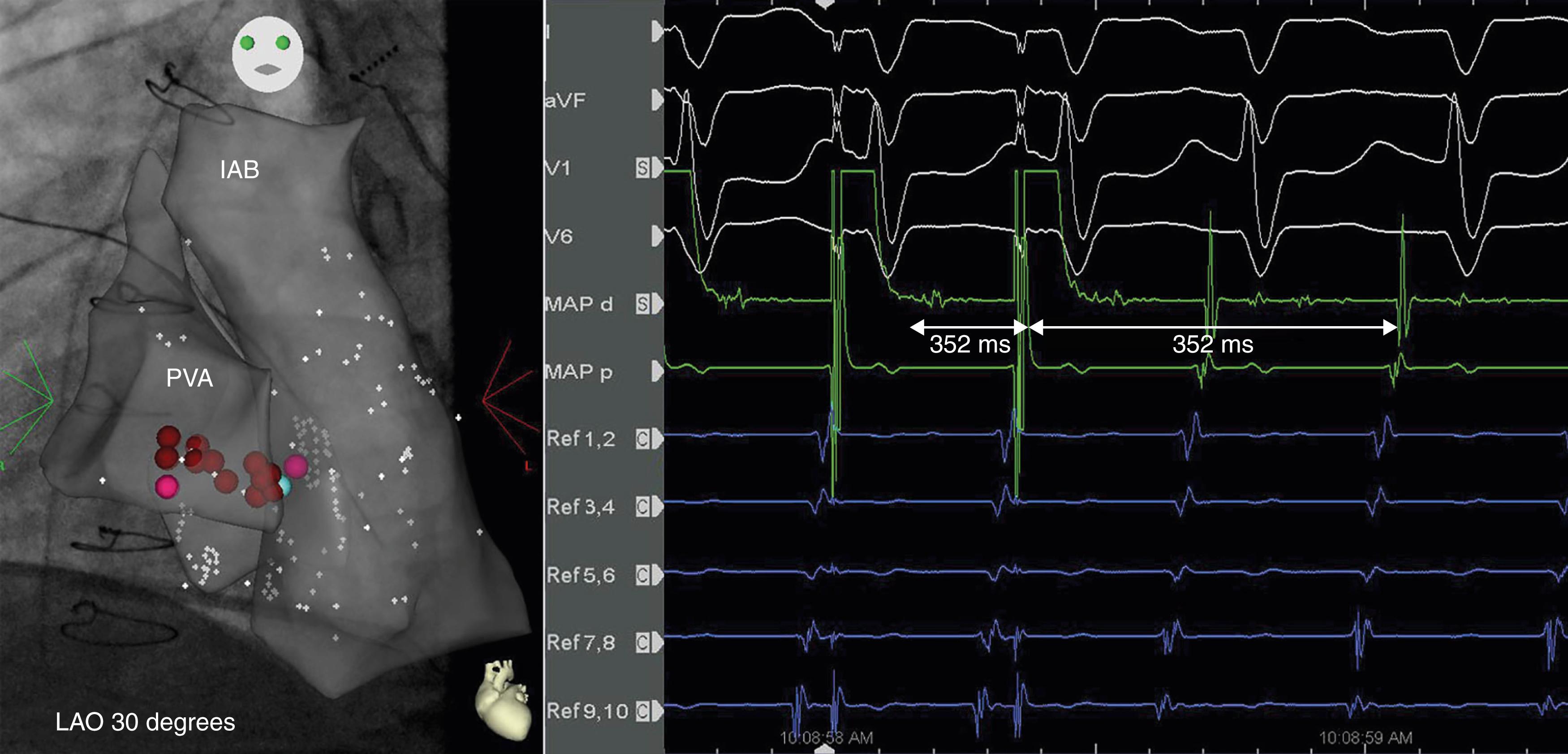
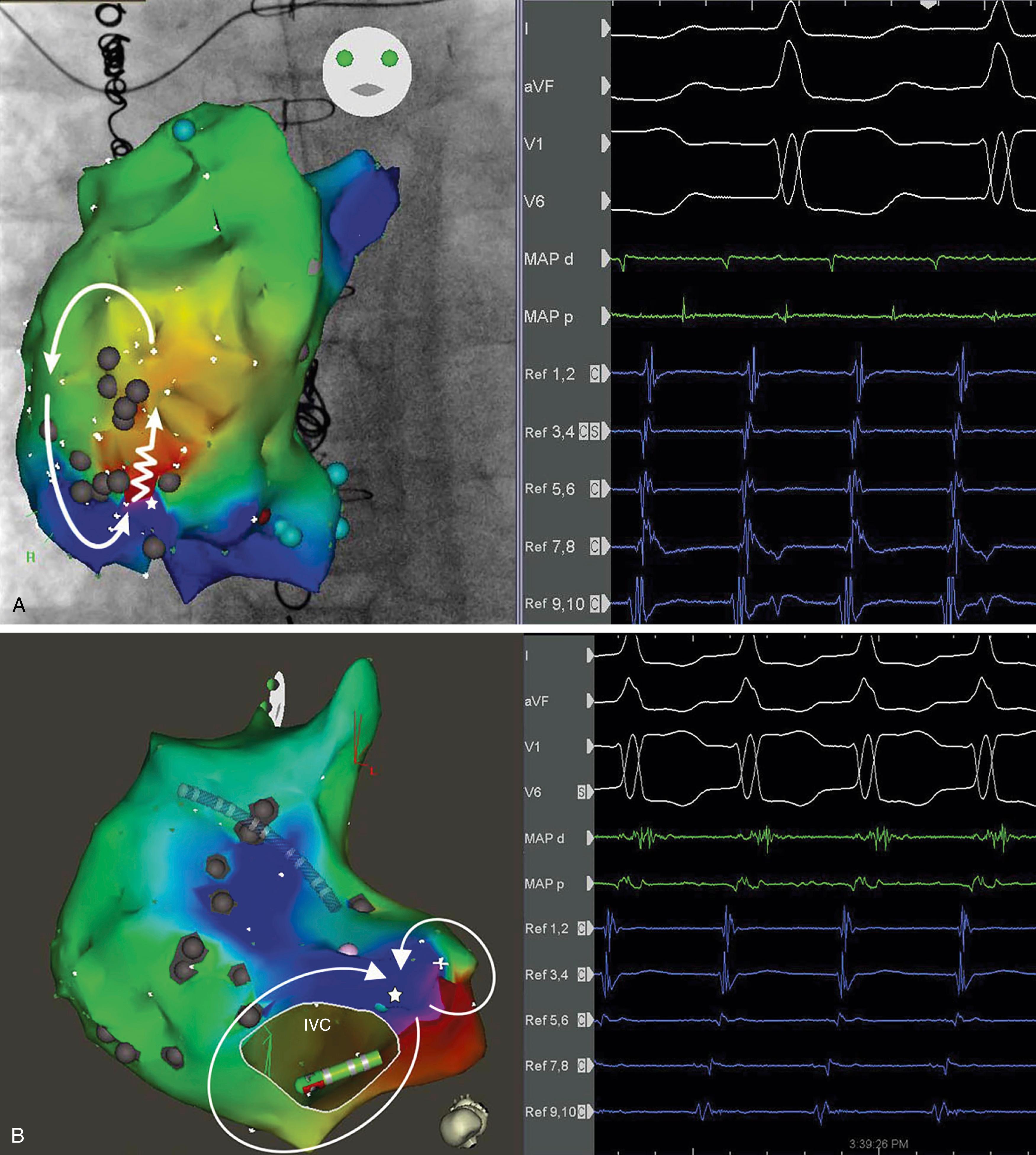
Perhaps most interesting was the finding of 13 arrhythmias in eight patients with a 1:1 AV relationship and either a short ( n = 7; 35–65 ms) or longer ( n = 6; 176–260 ms) ventriculoatrial (VA) interval during tachycardia. Using single ventricular premature beats introduced during tachycardia at varying coupling intervals, it was not possible to reset the atrium, with preexcitation indices ranging from 110 to 180 ms, and an AV response was seen on cessation of ventricular pacing with atrial entrainment, both strongly supporting AVNRT as the mechanism. In patients with the anatomic triad of atrial isomerism, an AV septal defect, and ventriculoarterial discordance, two AV nodes may be present, permitting a reciprocating tachycardia. The diagnosis may be made before invasive EP assessment by the presence of two different QRS morphologies with no evidence of preexcitation or invasively by the finding of two distinct His bundle EGMs in separate locations, decremental anterograde and retrograde conduction, and regular tachycardia CL with a 1:1 AV relationship anterograde over one AV node and retrograde via the alternate node. These findings highlight the potential for more simple arrhythmia mechanisms, despite the anatomic complexity, and stress the importance of comprehensive EP analysis of intracardiac activation patterns, diagnostic maneuvers during tachycardia, and entrainment.
The extracardiac TCPC was proposed to further reduce arrhythmia by minimizing surgical intervention within the right-sided atrium and baffling inferior venous return to the pulmonary circulation via an extracardiac conduit. Intracardiac access is gained by trans-baffle puncture or through a patent fenestration ( Fig. 115.5 ). MAT rotating around the right-sided AV valve and through the isthmus between the valve and oversewn IVC is again the most prevalent mechanism.

Many congenital cardiac lesions may have arrhythmias resulting from the constellation underlying anatomic features unrelated to surgery, as perhaps best typified by Ebstein anomaly. Eponymously described in 1866, Ebstein anomaly is characterized by failure of the posterior and septal leaflets of the tricuspid valve to delaminate from the underlying myocardium to which they are adherent, creating apical displacement of the leaflets and an “atrialized” portion of the RV. , The anterior leaflet is often enlarged and fenestrated, which gives the classic echocardiographic sail-like appearance. Failure of valve leaflet coaptation leads to varying degrees of tricuspid regurgitation, with dilation of the true tricuspid valve annulus and RA, facilitating MAT, most commonly typical AFL via the CTI, but also AF and FAT. This is often regarded as a consequence of the underlying anatomy because earlier surgical techniques were less successful than those for other lesions, and consequently intervention was deferred in many patients.
The structural and histologic abnormalities around the right AV junction are associated with a high prevalence of right-sided APs that are frequently multiple. Abnormal, highly complex EGM characteristics because of the nature of the underlying AV junction and neighboring myocardium make accurate differentiation of the relative atrial, AP, and ventricular components challenging during mapping. During AV reentrant tachycardia (AVRT), the VA timing is often prolonged because of slowed conduction within the atrialized RV, where the vast majority of pathways are located. The usual ECG in Ebstein anomaly displays low-amplitude QRS complexes in the anterior precordial leads with a right bundle morphology, indicative of delayed conduction within the right bundle itself or the atrialized portion of the RV. The presence of an AP with anterograde conduction can therefore preexcite the atrialized RV and “pseudonormalize” the ECG, giving rise to a QRS complex of normal morphology and duration ( Fig. 115.6 ).
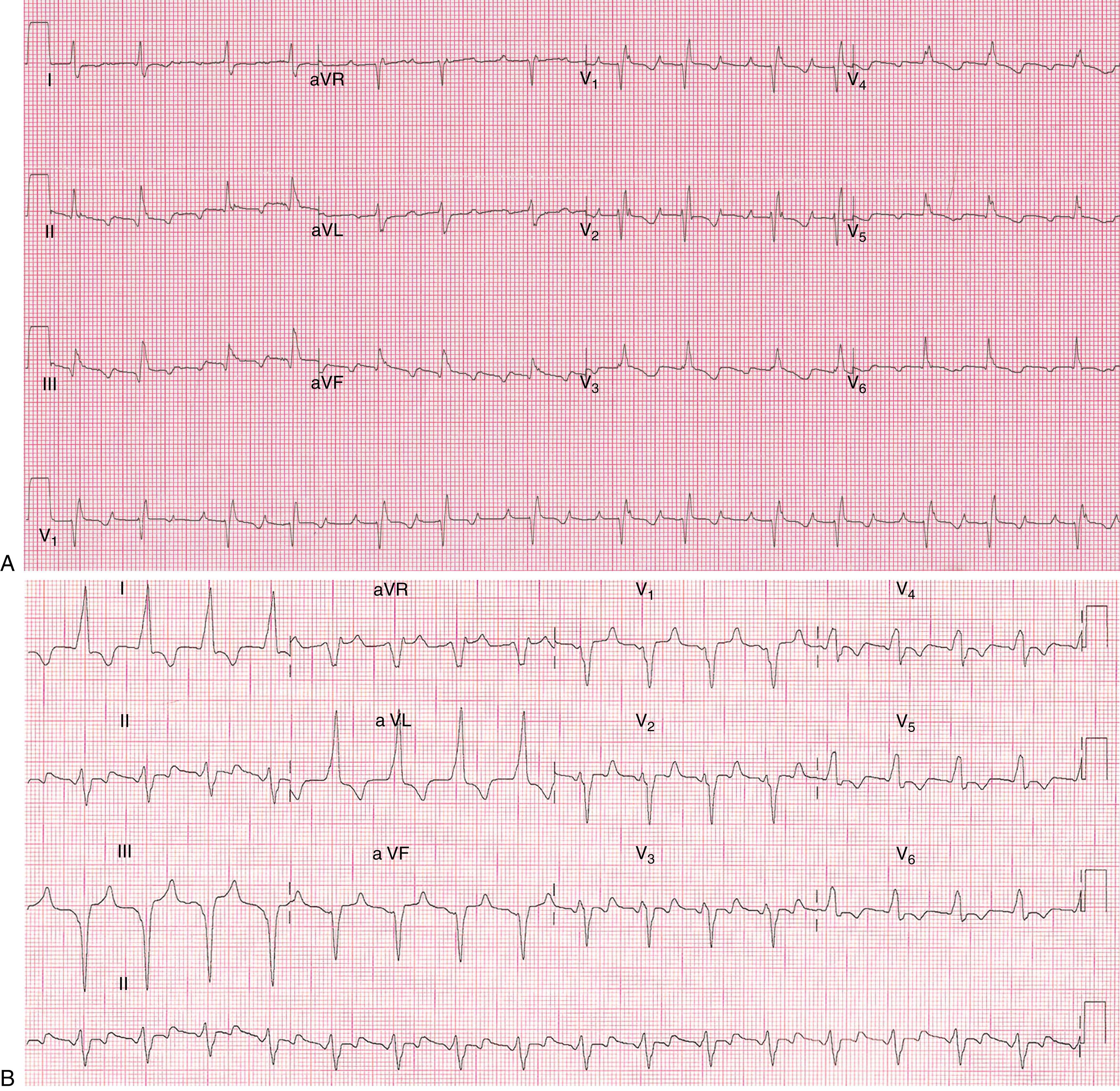
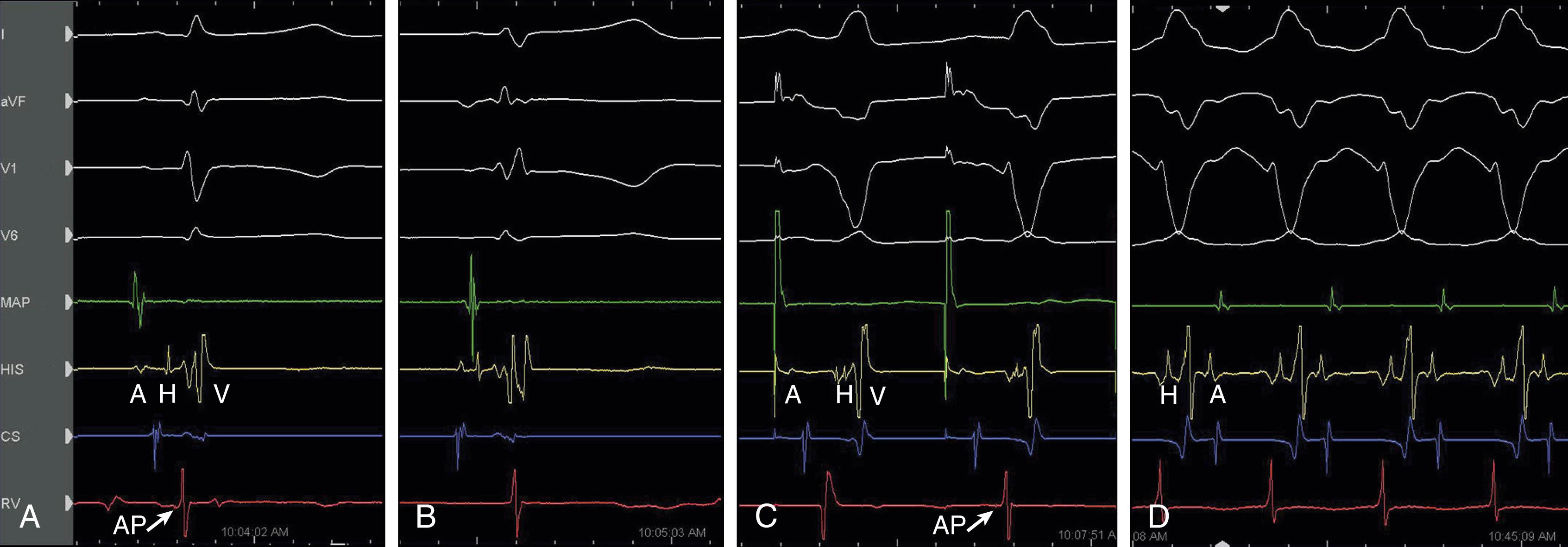
Surgical intervention in Ebstein anomaly has recently been reinvigorated with the advent of the cone reconstruction of the tricuspid valve but which limits postoperative access to the true right AV junction. A preoperative approach to arrhythmia management has been used by some centers to eliminate arrhythmia mechanisms that may hinder the postoperative course and be nearly impossible to ablate after the cone reconstruction. EP assessment of 42 patients before surgery (median age of 13.8 years) identified 56 different arrhythmia mechanisms in 29 patients (69%), including eight patients with no prior arrhythmic history or ECG features suggestive of an underlying substrate. In 14 of 21 patients with documented APs, 14 (66%) had a second mechanism identified, including additional accessory or atriofascicular fibers, AVNRT, MAT, and AF.
As the ACHD population ages, it is becoming increasingly apparent that AF will become a significant clinical burden and represents the next major EP challenge. A comprehensive analysis of 199 patients with a variety of congenital lesions identified the mean age of onset to be 49 ± 17 years, although onset occurred at a younger age in those with more complex lesions and was associated with right- and left-sided valvar disease in 31% of patients. Cerebral thromboembolic complications were reported in 13%, occurring in the majority before the onset of AF, suggesting that in patients with apparent isolated stroke, the presence of AF as an underlying etiology should be actively pursued. Importantly, it appears there is frequent and rapid progression from paroxysmal to permanent AF, supporting the notion that AF begets AF in ACHD and in other forms of cardiovascular disease.
The mechanism of AF in ACHD is not well understood. One important question is whether, in many patients with advanced RA remodeling, the pulmonary veins are implicated in the etiology of AF. If that is the case, will an ablative strategy primarily incorporating pulmonary vein isolation be successful? Supporting evidence for this comes from a series of 559 patients with tetralogy of Fallot, 41 of whom were found to have AF, the onset of which was associated with increased age and LA size, reduced left ventricular (LV) function, and the number of prior surgical procedures. LA remodeling has also been demonstrated in patients with chronic left-to-right shunting via an ASD, with LA enlargement, areas of abnormal bipolar voltage and reduced conduction velocity, and an increased propensity to AF induction, despite no reduction in atrial refractoriness. A temporal relationship between AF and organized MAT, however, is well recognized, documented to coexist in 33% and 31% in two studies in 199 and 149 patients, respectively, suggesting a mechanistic relationship (see Fig. 115.2 ). ,
In the presence of diffuse atrial EP remodeling, as may be encountered in ACHD, rapid activation from a focal or localized reentrant source with fibrillatory conduction to the remainder of the atria has long been an attractive mechanism. Locations of rapid RA foci identified in patients without structural heart disease include the superior vena cava, sinus node, and coronary sinus os. , This phenomenon has also been described in two ACHD patients with AF on the surface ECG. In one patient with a Fontan procedure, large parts of the atrium were activated in a regular manner, although one small area was found to display continuous local electrical activity. Ablation at this point terminated AF into an organized atrial tachycardia. In a second case, AF originated from a focal area of myocardium surrounded by dense scar with a narrow gap connecting the site of onset to the remaining myocardium.
Organized rotors as a mechanism of AF have been a major focus of research over the last few years. These were initially demonstrated in animal models and also in the structurally normal heart, using electroanatomic and noncontact mapping respectively. , Although the majority of rotors locate to the LA in studies using noncontact mapping and high-frequency spectral analysis, Lin found that paroxysmal AF in a small proportion of patients was driven by organized reentrant circuits dependent on conduction block at the CT that could drive fibrillatory conduction to large areas of atrial myocardium that were acting as bystanders. Ablation of gaps within the CT terminated tachycardia. In animal models, Ortiz et al. demonstrated the length of a line functional conduction block in the RA free wall is fundamental in determining fibrillation or stable reentry. A longer line of block creates a circuit of sufficient length to support a stable macroreentry rhythm. Reduction in tachycardia cycle length, coupled with changes in length and position of the line of block, generates one or two unstable reentry circuits, which change shape, disappear, and reform, ultimately generating AF.
Experience of AF ablation in ACHD is beginning to emerge. In 2019 catheter ablation for AF in ACHD was reported in a series of 58 patients (median age, 51 years) from a single center. The majority had congenital cardiac lesions of moderate to severe complexity. The specific lesions applied depended on the underlying substrate and associated arrhythmia, but all patients underwent PVI except two in whom this had been previously performed surgically, with other focal or linear ablation lesions in both atria as indicated. Overall, 122 procedures were performed, with multiple procedures performed in the majority (60%). At 1-year postablation, only one-third of patients remained in sinus rhythm, and freedom from AF 1 year after a second or third procedure was 40.9% and 36.5%, respectively. Multivariable predictors for AF recurrence were underlying anatomic complexity, persistent AF, and greater indexed LA dimension. These early results suggest that even with aggressive ablation strategies, interventional management of AF will be challenging in a significant proportion of patients and require multiple procedures. Ultimately, a better understanding of AF mechanisms and success of interventional strategies in the ACHD population will help guide case selection, procedural timing, and specific ablative strategies.
Become a Clinical Tree membership for Full access and enjoy Unlimited articles
If you are a member. Log in here